
Fly Fishing for Largemouth Bass – Pro Tips!
This article will thoroughly cover fly fishing for largemouth bass. While trout may get most of the attention from fly fishing anglers in freshwater, bass are quite popular as well. In most cases, bass are much more convenient as there are widely distributed throughout North America.
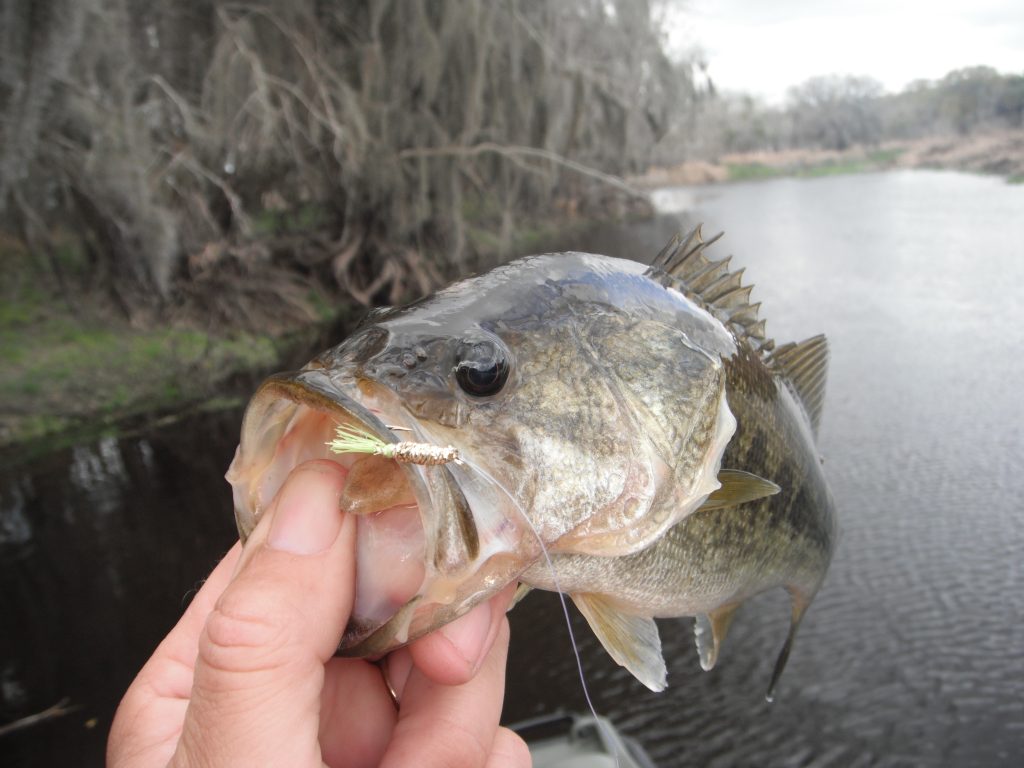
Largemouth bass prefer shallow water with a lot of cover. Aquatic grass and other vegetation is prime cover anywhere a largemouth bass is found. Man made cover such as boat docks, piers, bridges, and rip rap will attract them as well. While anglers can fly fish for largemouth bass in deeper water, the vast majority of bass caught on fly are done so in shallow water.
Fly fishing for largemouth bass
Tackle requirements for fly fishing for largemouth bass are pretty basic. Largemouth bass grow large and the flies used are larger. Therefore, slightly heavier tackle is required along with different lines.

Fly rods, reels, and lines are sold in “weight “ designations. This appears on the tackle like this “wt”. This makes it very easy to match the tackle components together. An 8 wt outfit is a good all-around outfit for largemouth bass.
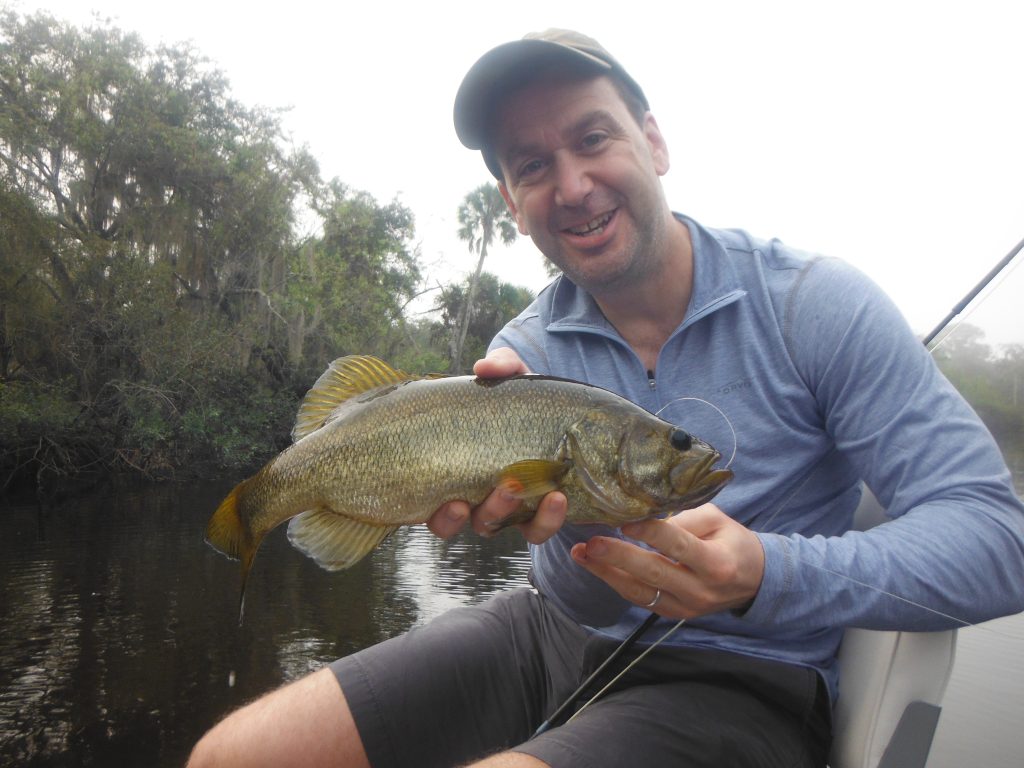
Largemouth bass grow larger than some other freshwater species. They also tend to be found around heavier cover such as boat docks and thick vegetation. The flies, especially poppers, are also larger and more wind resistant. Finally, largemouth bass are normally found in shallow water. For all of these reasons, the best largemouth bass fly rod, reel, and line combination is an 8 wt outfit with a floating weight forward line.
There are special lines that are specifically designed for casting large bass flies. These are called weight forward or even bass bug taper lines. This means that they are heavier near the end of the fly line to facilitate casting these wind resistant flies. Since largemouth bass for the most part will be pursued by anglers fly fishing in fairly shallow water, a floating line is the best choice.
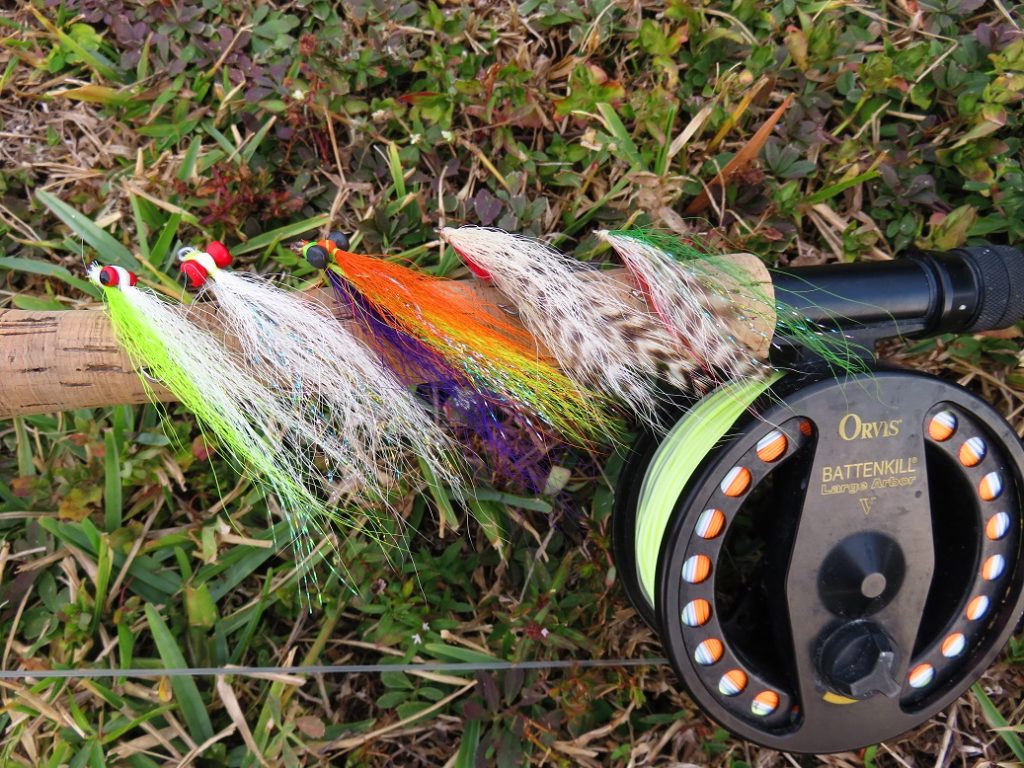
Fly patterns for largemouth bass
There are endless fly patterns that anglers fly fishing for bass can choose from. Fact, the choice can be overwhelming. However, the bass are often less selective than the anglers. There are a handful of fly patterns that will cover just about every situation and angler will encounter for both largemouth bass.
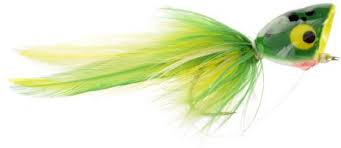
Poppers are flies that float on the surface. They can be made of Styrofoam, cork, or any material that floats. Some are even made from deer hair. Most have rubber legs and usually tales that undulate on the surface seductively when twitched. Most also have a concave mouth that produces a “pop” when twitched sharply, thus the name. Poppers work very well for largemouth bass. Larger poppers are usually used on largemouth bass .
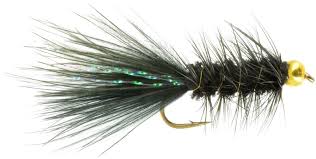
The Wooly Bugger is a terrific all round fly that will fool just about every species in freshwater. Tiny versions work very well on trout and panfish. Larger versions are very effective on both species of bass. Darker colors such as black, brown, and olive are most popular. It is thought that these flies realistically imitate crawfish and other forage that bass find on or near the bottom. A #2 size is excellent for largemouth bass.
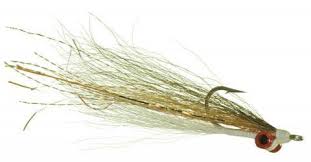
The Clouser Minnow was designed by legendary smallmouth bass angler Bob Clouser on the Susquehanna River. It is a tremendous fly that has crossed over and is arguably the most popular saltwater fly. It can be tied in a variety of manners to imitate crawfish and helgramites as well as bait fish depending on the weight of the eyes used and the color of the material. It is an excellent all round fly for largemouth bass.
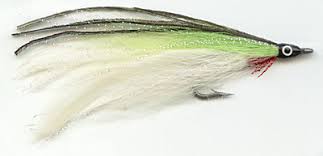
The Lefty’s Deceiver was created by legendary fly angler Lefty Kreh. It is an unweighted streamer pattern that can be tied to mimic any type of bait fish. It has splayed feathers and puts out a lot of action in the water. Many anglers who are fishing for largemouth bass will tie a weed guard to help reduce hangups.
Largemouth bass fly fishing leaders
A leader is used between the fly line in the fly. Fly line is thick and easy to see and know bass would take a fly if it was tied directly to the fly line. Leader length and strength will vary depending on the application. Leaders are tapered, which means they are thick at the fly line and then taper down to the fly end. This helps the fly “turn over” and extend out the length of the fly line and leader, instead of collapsing on the surface in a ball.
video on fly fishing for bass
Anglers fly fishing for largemouth bass can use a slightly shorter leader in most instances. A 6 foot leader is usually plenty, especially when fishing around weeds and other cover. Also, shorter leaders are preferred when casting large poppers and deer hair bugs. It is difficult to get a long leader to turn over with these very wind resistant flaws. Leaders testing around 10 pound test are usually fine. Many manufacturers offer a tapered leader specifically designed for largemouth bass fishing.
Fly fishing techniques for largemouth bass
The techniques used when fly fishing for bass apply to both largemouth bass and smallmouth lot bass to some degree. Therefore, they will both be covered in one section. Keep in mind, largemouth bass are predominantly found in ponds and lakes and slow-moving rivers. Smallmouth bass are found in many streams and small rivers as well as large, deep, clear lakes.
Most anglers fly fishing for largemouth bass do so working the shoreline shallow cover. This is where largemouth bass are often found. Also, it is much easier to present a fly in shallow water than it is to get the fly deep. Fly fishing and shallow water just go together, no matter the species.
Fly fishing for largemouth bass in ponds and lakes
Most anglers fly fishing for bass along the shoreline in lakes start off with some type of surface fly. Poppers and deer hair bugs are great fun to fish and produce some exciting strikes. It also eliminates the need to deal with the fly getting hung up and submerged vegetation. The popper or bug is cast out close to the cover and allowed to settle. With the rod tip help low the angler pulls on the fly line with the stripping hand, causing the bug or popper to pop sharply on the surface. This is repeated several times than the fly picked up and recast to another spot.
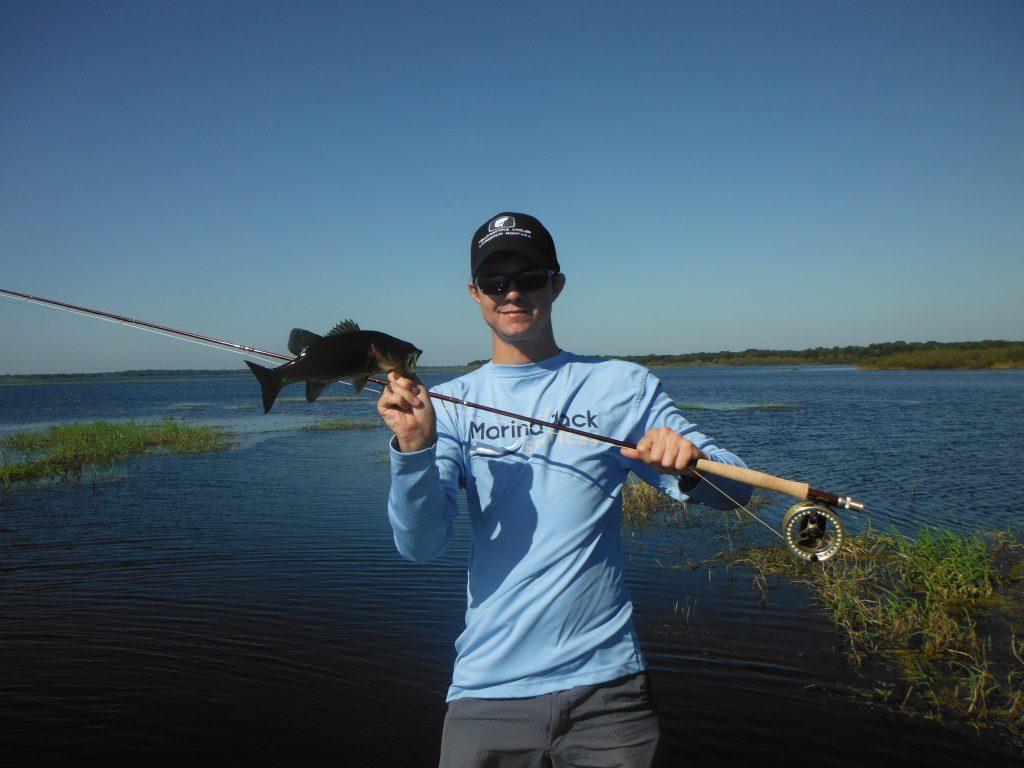
One of the main obstacles anglers have to overcome when fishing for largemouth bass in ponds and lakes is the fact that the angler has to impart all of the action and movement to the fly. This is especially true for trout anglers who are used to fishing and streams with a lot of current. In ponds and lakes, the angler needs to make the fly look real in order to induce a take.
This fact means that anglers have to change their technique just a bit when fishing for bass in lakes and ponds. It is always best to keep the rod tip low, near the surface of the water when retrieving the fly. The angler should impart all of the action to the fly using the stripping hand in the fly line, not the rod tip. This is true of both surface and subsurface flies.
When a strike occurs, the angler should use a “strip set”. This means that just as with retrieving the fly, the hook is set using the stripping hand. When a bass takes the fly, the angler keeps the rod tip low and pulls sharply with the stripping hand removing any slack and getting the point of the hook started in the fishes mouth. Then, a second or two later the rod tip is lifted smoothly up. This method will result in more bass hooked.
If the bass will not take a surface fly, it is time to switch and use a fly that works a bit deeper. Wooly buggers, Clousers, and deceivers are all good choices. Largemouth bass tend to prefer a substantial meal, so larger flies are a better choice when that is the target species. Anglers should fish the fly just as they were the lure, close to, around, and through shoreline cover. An intermediate sink tip line is best in this application.
While fly fishing is not designed to be done in deep water, there will be times when anglers fly fishing for bass in lakes will need to move out a bit deeper. A sinking line with a fairly heavy Clouser Minnow or Wooly Bugger is the best option in this situation. Anglers need to be patient and give the line plenty of time to sink to get down to where the fish are.
Fly fishing for largemouth bass in rivers
Many anglers associate fly fishing with rivers, and for good reason. Fly fishing really came about for trout fishing in streams. Most anglers who do fly fish for bass probably are fishing for smallmouth bass in streams and rivers. Largemouth bass can certainly be caught in rivers, especially those with less current. Largemouth bass do not like to fight the current the way smallmouth bass will.
There are a couple of advantages to fly fishing for bass in rivers. The primary advantage is that fish are much easier to find. Lakes can be huge and bass may be anywhere. In rivers, fish will usually be found in certain locations, making them easier to find. Also, in many cases, no boat is required. Finally, rivers offer protection from the wind on breezy days.
Shoreline cover will hold bass in rivers. Any fallen tree limb or any other obstruction that breaks the current can be a likely ambush spot. Anglers can cast poppers and surface flies if the current is not too strong. Clouser Minnow patterns and other streamers work best if current is present.
Deeper holes between fast moving runs are prime spots to hold bass in rivers. Boulders and rock ledges will only enhance these spots. Bass are not like trout and will usually not hold in the fast water. Deeper holes will have crayfish that bass love to feed on. A Clouser on a sink tip line is a great choice for fishing these spots.
Lagemouth bass will stage in the slack water behind large rocks and boulders in a stream or river. This is a classic fish-holding spot! The eddy will allow the bass to ambush prey while not expending a lot of energy. A popper tossed into the slack water may draw a strike as will a Woolly Bugger or Clouser drifted past.
One thing river bass anglers do have to deal with is the ever-changing conditions. Water level, flow, and clarity are all components that will affect the fishing. Anglers should always put safety first and not wade or fish rivers that are running high and fast. Fishing is usually poor at this time anyway. Most anglers prefer the water to be a bit low and clear. This will concentrate the fish and they will be easier to catch. It is also much safer to fish as well.
In conclusion, this article on fly fishing for largemouth bass will help anglers catch more of the most popular freshwater game fish!